Corpus of the Inscriptions of Campā

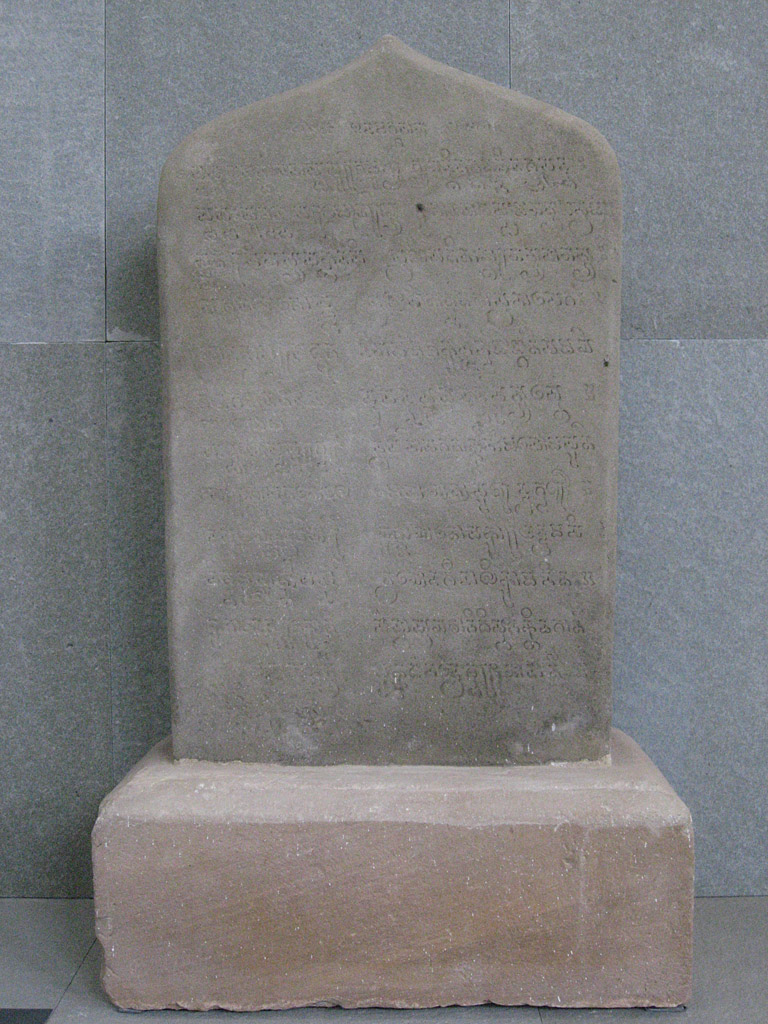
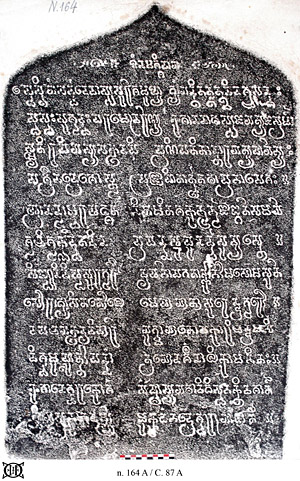
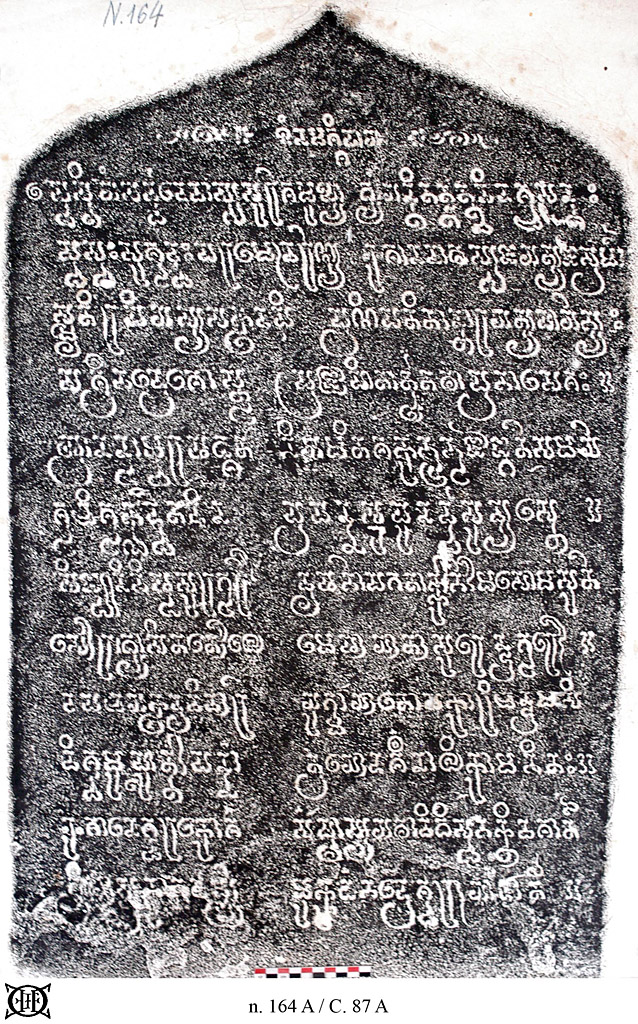
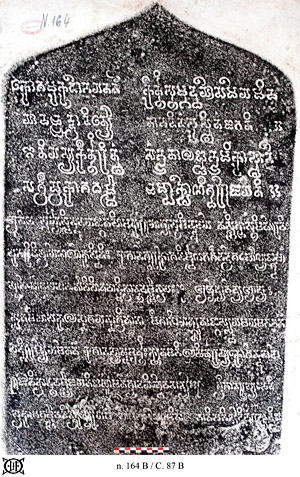
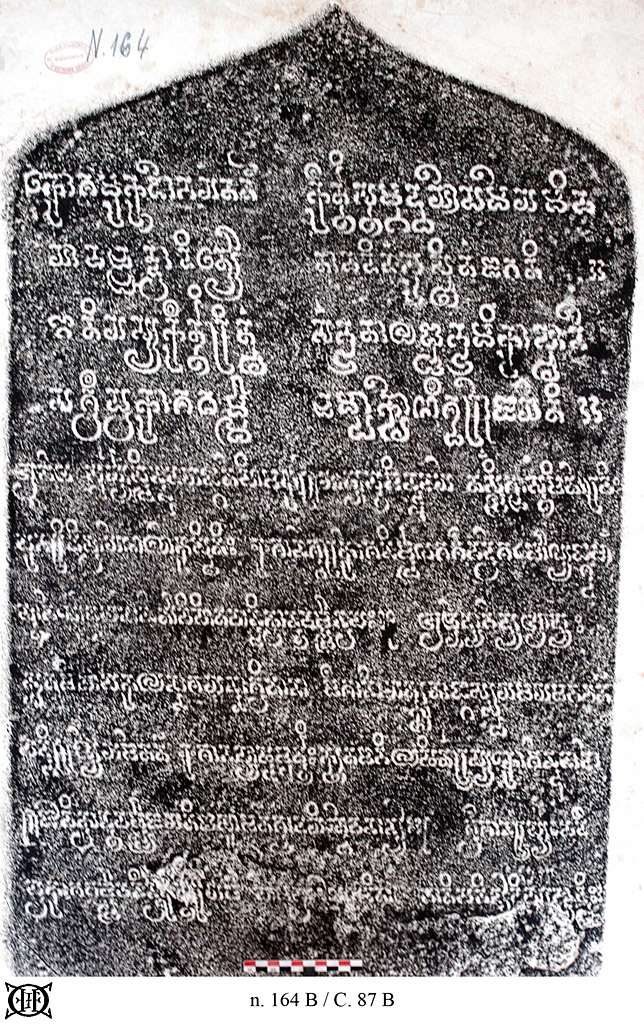
C. 87 Stela from Mỹ Sơn B6
Please note: you are reviewing a preprint version of this publication. Contents here may change significantly in future versions. Scholars with specific interests are urged to consult all cited bibliography before using our texts and translations or drawing other significant conclusions.
Text The stela is engraved on two faces. Face A bears an incipit and 12 lines; face B bears 11 lines. Both faces are written in SanskritIt should be noted that the last 7 lines of face B are executed in a significantly smaller lettering..
Date 2 waxing Śuci (i.e. Jyeṣṭha), 609 Śaka (19 May 687 CE). 1
Origin Site of Mỹ Sơn (Quảng Nam).
This stela was found near the western side of monument B6 at Mỹ Sơn in 1903 during excavations carried out by EFEO (Parmentier 1909: 381 and Parmentier 1919: 11). An archaeological photograph taken in September 1903 (Ghesquière et al. 2005: 56) shows this stela standing next to this monument, side by side with the stela bearing C. 81, which had been found near B1. In the case of the present stela, the findspot is likely its original location, for the base was found right beside the stela itself. The two stelae (this one with its base) were moved to the Tourane Museum in 1918, and its inventory number 1,1 there was published in Parmentier 1919: 11. We identified the inscription at the same museum, now called Bảo tàng Điêu khắc Chăm Đà Nẵng (Museum of Cham Sculpture at Đà Nẵng) in 2009.
Edition(s) First published, with French translation, in Finot 1904d: 925-928; whence, with English translation, in Majumdar 1927: 28-31; whence Golzio 2004: 21-23. Newly edited in Đà Nẵng Catalog: 229-233, whence the present edition.
Facsimiles
- Estampage: EFEO 328
- Estampage: EFEO n. 164
The following text was edited by Arlo Griffiths.
Face A.
Face B.
incipit ((siddham)) || oṁ namaś śivāya ((siddham)) ◇ Finot omits all liminal signs and oṁ. The words ((siddham)) are expressed figuratively. On this figure, and on the form of the double daṇḍa, cf. ECIC I, p. 352 n. 10 and p. 361 n. 28, as well as ECIC II, p. 279. — ☉ svasti ◇ Finot omits the spiral-shaped fleuron and inserts after svasti the sign || which is not actually there. — I s(a)sureśamukhyā ◇ the reading with short a in sa is uncertain. Judging only by the estampage, one might be inclined to read sā, but this would be unmetrical. See the note to our translation. — II sa śrībhadreśo ◇ so śrībhadreśvaro Finot. — prajāhitārtthaṁ ◇ prajāhitārthaṁ Finot. — tathā ◇ Finot notes “Tathā serait à supprimer metri causā ; mais il paraît utile pour le sens”. This statement is based on a misidentification of the stanza as an Āryā. — III °dveta° ◇ °dvaita° Finot. Understand °dvaita°. Cf. another case of e for ai in st. X below, where the sequence chādayitvaiva nānyeḥ allows comparing the shapes of e and ai. — VI (śrīmān prakāśadharmmā) ◇ [śrīmān prakāśadharmmo] Finot. Finot explains: “Lecture restituée d'après de simples traces de lettres”. The ending -o in Finot's restitution is based on the wrong understanding, widespread even into recent literature, that the king's name was Prakāśadharma, rather than Prakāśadharman. — VII tat·kīrttistambha° ◇ tat kīrttistambha° Finot. It seems better to make tat the first member of a compound. — between VIII and IX api ca ◇ athaiva Finot. — IX tasmiṁś cāstam° ◇ tasmiṁśāstam° Finot. This printing error was corrected in BEFEO 15.2, p. 190. The stone clearly shows ścā. — aṅśumām̐s ◇ aṁśumāṁs Finot. — tāv e(vodayasaṁ)ditau vi° ◇ tāv e ⎼ ⏑ ⏑ ⎼ ⏑ tābhi° Finot. The proposed restoration is largely conjectural, but what remains visible on the stone allows it (and does not allow a reading °hitau). — X acchedy(A)° ◇ acchedyā° Finot. Finot's reading is required for sense and meter, but the inscription actually shows acchedya. No difference is discernible from the two cases of dya that immediately follow. That the scribe was not infallible is clear also elsewhere in this stanza. — °mūrttiḥ ◇ Finot; correct °mūrtteḥ. The correction was proposed to us by Yuko Yokochi. — abhilaṣitam̐ ◇ abhilaṣitaṁ Finot. — nānyeḥ | ◇ nānyaṁ Finot. Correct nānyaiḥ |. — XI °bhedī ◇ °bhede Finot. — Finot was unable to read anything of this stanza beyond prakāśadharmmāvanīndra. The reading bhāti savid(y)[u]d iva ra(vyadr)iḥ is rather uncertain as a whole, but is the only reading reading we have been able to think of that suits the meter and seems permissible judging by the estampage.
Translations
English
Success! Om! Reverence to Śiva! Success! Hail!
I. Him upon whom all the gods, together with Sureśa (Indra) at their head,2 as well as all good people who know His nature, meditate; independent, very pure, ultimate, sublime; He, Īśānanātha, triumphs always!
II. May that Śrī Bhadreśa, and Prabhāseśa too, even a thought of Whom, even once, saves those who are prostrated from evils, be for the good of the people!3
III. When the era of the Śaka kings, denoted by six hundred, the (void) ether [0] and [9] Ānandas4 had elapsed, and had reached the second day of the waxing [fortnight] of Śuci (i.e. Jyeṣṭha),5 well extended over the good (lunar mansion) Punarvasū,
IV. when Jupiter had entered Leo; when the Sun, Mars and Mercury were in Taurus; when Libra had been occupied by Saturn; when Venus had arrived in Aries,
V. on the day of the prosperity-promoting Sun (i.e. on Sunday), when the favorable Moon6 had arrived in Gemini, around the thirteenth nālikā (unit of time) falling in the muhūrta (watch) of the Viśva[vasu]s,
VI. after having installed, with due rites, at the urge of his own devotion, a sheath for Īśānesvara, the illustrious Prakāśadharman gave a crown to Bhadreśvara.
VII. May this pair of sheath and crown, as it were a likeness7 of two pillars of his fame, abide on earth as long as Sun and Moon (shall last).
VIII. So triumphs he, Śrī Prakāśadharman, king of Campā, whose fame, originating in this manner, has fittingly taken root!
And also:
IX. When this Sun here rises, the Moon sets; and when that Moon rises, the Sun sets: this is normally the situation in the world. But the king Vikrāntavarman has installed both of them — the spotless Moon which is the sheath of Īśānesvara, and the Sun which is the crown of Bhadreśvara — bound together in their ascendancy.
X. Īśāna here, who cannot be cut, who cannot be split, who is primordial, who heals the misery (kṣata) of all his followers here below, himself, with his body damaged, pronounced this, which is to be proclaimed by the competent: the king Vikrāntavarman, having covered that damaged [liṅga], which is specially desired by Īśāna, (although he) has eight manifestations8 (in which he already resides), with the Moon which is the silver sheath, and with nothing else, triumphs, respected by many!
XI. … shines, breaking forth from Īśāna's silver sheath (which emits white rays of light), like the mountain of sunrise being shrouded by lightning. [The white light] is the fame of the king Prakāśadharman!9
French
TO BE SUPPLIED
Secondary Bibliography
- Schweyer 2005b: 40, fig. 2.
- Schweyer in Baptiste & Zéphir 2005: 180-182.
- Schweyer 2008b: 13-14.
Notes
- The difference of script-size has suggested to Finot 1904d: 925 that the last 7 lines of face B might be a later addition.
- The construction sasureśamukhya- seems redundant. One could easily read here sāsureśamukhya-, which would arguably yield a better sense ('together with the best of demons'), but would be unmetrical.
- On the divine triad Īśānesvara, Bhadreśvara and Prabhāseśvara, see C. 96 B, l. 24-25.
- Golzio translates “some Nandas” and notes that his “translation is based mainly on two facts: 1. There is no word ānanda as a numerical symbol; 2. For the calculation of the complete date (see next footnote) only one solution can be evaluated as valid, the reading of Śaka 609.” Golzio might have referred to the corrigendum published in BEFEO 15.2, p. 190: “traduction, st. III, lire : « en l’an des rois çakas déterminé par six cents, l'atmosphère et les Nandas (609) ». [Correction de M. Fleet.] Supprimer la note.” This does not explain what to do with the ā-, but since the value 9 is well attested for nanda, and since this word is in its primary sense synonymous and almost identical in shape to ānanda, the hypothesis of their equivalence seems natural enough.
- On the name of the month, see ECIC I: 367.
- The fact that, unusually, both Sun and Moon receive here special positive attributes probably has to be seen in connection with the special attention allotted to these two heavenly bodies also further on in this inscription (st. VII, IX, XI).
- The combination of upameyam with iva seems redundant.
- On the eight manifestations of Śiva (which are different from the eight names listed by A.-V. Schweyer in Baptiste & Zéphir 2005: 181), see ECIC I: 368.
- There is probably a pun here on the name Prakāśadharman, which contains the word prakāśa meaning 'radiance'. But the lacuna in the text prevents us from understanding the exact significance of the poet's choice of words here. As it stands, our translation is based on the assumption that the image of the comparison lies in the sun, comparable to the liṅga's crown, being on top of the mountain (comp. to the liṅga), surrounded by lightning (comp. to the silver sheath or its rays of white light). Fame is usually regarded as white in Sanskrit poetry, so that it should be compared to the rays of the silver sheath, not to the light of the golden crown. The lacuna would, we suppose, have contained an expression for Śiva with his golden crown. The Śiva in the liṅga is of course invisible to the common eye but can be visualized by meditation.


